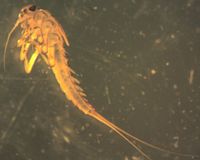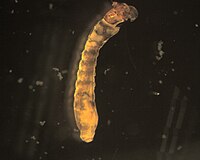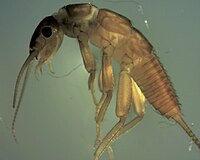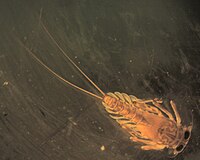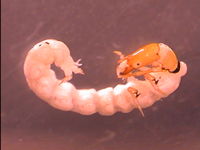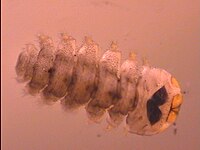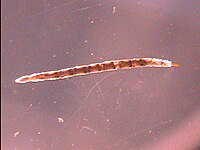Cold River
From WikiEducator
The following are the most common invertebrates collected from this stream site.
Contents
Baetis
- Order
- Ephemeroptera
- Family
- Baetidae
- Genus
- Baetis
- Common name
- The Little Olive
- Tied fly
- Sawyer Pheasant Tail Nymph
This mayfly has three "tails" and a unique head shape. Its gills are oval shaped and insert dorsally. More mature nymphs have long, dark wing pads.
Image of the long, dark wing pads.
Chironomidae
Midge larvae tend to be the most common macroinvertebrate at our sites. As with other Diptera, there are no true jointed legs. Chironomidae do have a pair of prolegs at each end and preserved individuals tend to curl into a 'C'. Identification past family requires slide-mounted heads. We have seen philopotamid caddisflies misidentified with the chironomids and we suspect that that happens when samples are being sorted from trays. Under a microscope, six prominent legs can be seen on members of the caddisfly family Philopotamidae.
More information on Philopotamidae.
Simuliidae
Simuliidae appear rather like bowling pins with heads. Relatively speaking, we collect few members of this family and have we have not identified them past family at this point.
Click here for a close up image of the heads.
Baetidae
This mayfly has either two or three cerci ("tails") and a unique head shape. Its gills are oval shaped and insert dorsally. Commonly encountered genera include Acerpenna, Baetis and Pseudocloeon.
More information on the genera:
Capniidae
Capnia stoneflies have hind wing pads that are are broad as they are long. An important distinction of the Capniidae family is the membranous pleural folds that run down the posterior abdomen segments 1-9. These look like two lines running parallel down the back of the abdomen. Capnia are distinguished by femurs and tibia of forelegs with less than 20 fine hairs and no dorsal femoral fringe hairs.
Epeorus
- Order
- Ephemeroptera
- Family
- Heptageniidae
- Genus
- Epeorus
- Common name
- The Quill Gordon
- Tied fly
- Quill Gordon
This is the only Heptageniidae genus present in this area with two tails!
Chimarra
Chimarra are distinguished from the other Philopotamidae by a prominent asymmetrical notch in the frontoclypeus as well as a prominent process on the femur which bears a single hair (seta).
Images of the asymmetrical notch and prominent process.
Blepharicera
This dipteran is characterized by six prominent "suction cups" on its ventral side and has tufts on the sides of abdominal sections.
Image of the ventral side.
Hydropsyche
- Order
- Trichoptera
- Family
- Hydropsychidae
- Genus
- Hydropsyche
- Common name
- spotted caddis
- Tied fly
- dark cahill
Hydropsyche are net-spinning caddisflies and share most characteristics with other members of the Hydropsychidae, including the Ceratopsyche. Hydropsyche are distinguished from Ceratopsyche by the presence of scale hairs and minute spines on the three most posterior abdominal segments.
More information on the Ceratopsyche can be found here. Image of the sclerites in the intersegmental folds.
Ceratopogonidae
Members of this family look like very straight Chironomidae. They are very long and thin with a distinct head capsule and no prolegs. Some in the lab call them 'bamboo sticks' with eyes.
Image of the distinct head capsule.

